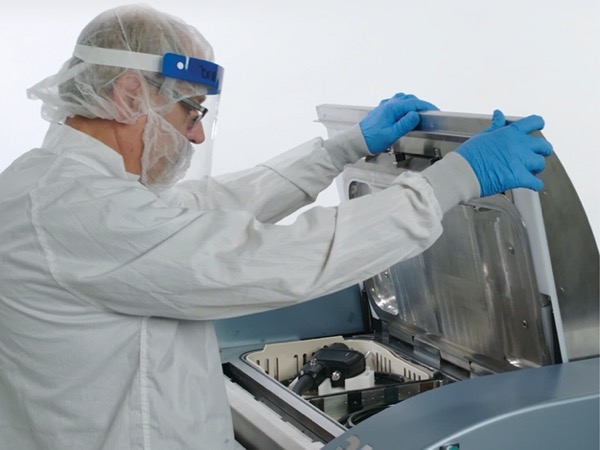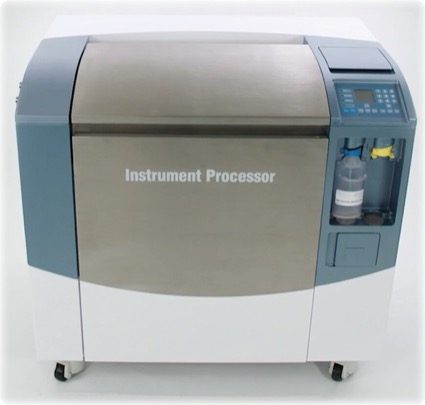Originally published by our sister publication Gastroenterology & Endoscopy News
Las Vegas—A fully automated process for cleaning duodenoscopes after clinical use far outperformed manual cleaning conducted by trained technicians adhering to manufacturer specifications, according to a comparative study.
Cleaning—the step taken before high-level disinfection—is widely regarded as a weak link in preventing transmission of pathogens when scopes are reused. Automated processing using turbulent flow technology might be the answer, according to researcher Michael O’Donnell, MD, MBA, a fellow in the Division of Gastroenterology and Hepatology at NYU Langone Health, in New York City.
In this study, conducted with Olympus TJF-Q180V duodenoscopes, 21 of 48 scopes were cleaned manually after endoscopic retrograde cholangiopancreatography (ERCP). The remainder were cleaned with the automated proprietary cleaning system called MACH I (Parametrik). The instrument channels and distal elevator areas were then sampled for residual protein and carbohydrates.
After cleaning, two of the 21 manually cleaned duodenoscopes had protein levels exceeding the FDA safety threshold. In addition, three of the manually cleaned duodenoscopes exceeded the FDA threshold for carbohydrates. In contrast, none of the duodenoscopes that underwent automated processing exceeded either threshold. Despite the limited size of the study, the difference for these outcomes combined was significant (P=0.03).
The difference was reflected in the average residual contaminants. After processing, the residue levels in scopes cleaned automatically were a fraction of the levels in scopes cleaned manually for both protein (0.16 vs. 4.88 mcg/cm2) and carbohydrates (0.14 vs. 1.09 mcg/cm2).
Perfect Adherence Is Difficult
“As seen in this study, manual cleaning can be prone to error,” said Dr. O’Donnell, who presented the data at the 2021 annual meeting of the American College of Gastroenterology (oral paper presentation 17). He said perfect adherence to the many steps of manufacturer cleaning instructions is “difficult to achieve.” Failure to adhere to the steps, which can be tedious, is considered a major obstacle to cleaning success.
After several outbreaks of infection linked to duodenoscopes that remained contaminated after standard cleaning and high-level disinfection, numerous non–outbreak-initiated studies found that contamination rates were substantial, whether due to human error or persistent bacterial colonization resistant to standard cleaning. In one meta-analysis of these studies, the estimated contamination rate after cleaning was 21.5% (EClinicalMedicine 2020;25:100451).
The solutions proposed to reduce or circumvent the risk of contaminated scopes have included redesigns to facilitate cleaning, single-use endoscopes that eliminate reuse and automated cleaning technology. Several automatic processors have been showing promise, according to a report issued by the American Society for Gastrointestinal Endoscopy (Gastrointest Endosc 2016;84[6]:885-892).
Addressing Bioburden
Biofilm formation has proven to be one of most significant challenges in effective reprocessing of duodenoscopes, according to several sources, including the 2016 ASGE review. Notoriously difficult to eliminate during standard cleaning, it is not necessarily overcome by high-level sterilization if it is not removed during the manufacturer’s protocol for cleaning.
The turbulent flow technology used in MACH I automated cleaning systems tested in the study presented by Dr. O’Donnell creates shearing forces that appear to be more effective for removing biomatter overall and biofilm specifically, he said. His data suggest that an effective automated system is better than manual cleaning both in achieving complete or near-complete elimination of the bioburden during scope reprocessing, and reducing or eliminating the potential for human error.
The FDA approved the MACH I cleaning system for sale, but it is not yet “available for purchase by hospitals,” Dr. O’Donnell said. Until it is, the company has a processing center in the New York City area and offers a pickup and delivery service, which he said will be expanded to other cities.
Although larger validating trials are needed, these results suggest that a fully automated cleaning process might be “a viable replacement to manual cleaning,” Dr. O’Donnell said.
Automation to Reduce Chance of Human Error
Numerous studies are leading to the conclusion that meticulous adherence to the cleaning protocols are unlikely to be the answer to this long-standing problem, commented Adarsh M. Thaker, MD, an advanced endoscopist within the interventional endoscopy service of the Vatche and Tamar Manoukian Division of Digestive Diseases at the University of California, Los Angeles.
“For decades, ineffective manual cleaning has repeatedly been identified as a factor in endoscope-related infections due to the complexity and operator dependence of the manual cleaning steps,” said Dr. Thaker, who has written frequently on this topic, including in a survey study three years ago on duodenoscope reprocessing practices in the United States (Gastrointest Endosc 2018;88[2]:316-322.e2). “Automation of these steps,” he said, “can minimize the opportunities for human error in endoscope reprocessing.”
—Ted Bosworth
Dr. O’Donnell reported no relevant financial disclosures. Dr. Thaker reported a financial relationship with Boston Scientific.


